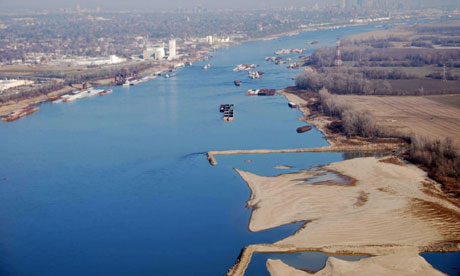How climate change climbed up the business agenda
The problem is not just an issue for activists, as extreme weather events put sustainability centre stage for business
-
Brendan LeBlanc
- Guardian Professional, Saturday 15 June 2013 02.21 AEST
- Jump to comments (2)

Climate change, deforestation, sustainable sourcing. Voices of concern over these issues – and more – aren’t only those of activists or the environmental community. Increasingly, disparate stakeholders and investors are chiming in. What was once a murmur is now a chorus, often built into business plans and integrated into corporate agendas.
In a recent preview of the 2013 proxy season, Ernst & Young reported that 45% of shareholder proposals focus on environmental and social topics. Interestingly, nearly one third of climate change and other sustainability proposals were withdrawn, indicating dialogue between corporations and shareholders on these issues that has satisfied both parties.
Shareholder expectations have historically pushed the corporate agenda, but why the growing interest in greener topics? Environmental and social issues – in other words sustainability issues – interest shareholders because they are strategic risk-management issues. Leading companies are taking their cue accordingly, renewing their focus on the need for resource efficiency and scenario planning. This response spans large industrial sectors including oil and gas, agriculture, food and beverage, manufacturing and utilities.
What other trends are solidifying a new sustainability minded business reality? A recent survey by Ernst & Young and GreenBiz queried sustainability executives (annual revenues of $1bn plus) representing 17 industries. More than 50% expect natural resources to affect their company’s core business.
Water-related risks gained the greatest notoriety in the corporate sphere, and for good reason. A full 76% of respondents ranked water as the top cause for concern among resources “most at risk”. At its peak last summer, the North American drought crippled commerce along the Mississippi river, almost forcing closure of the largest continental shipping lane in the US. Munich Re cited the drought as “the single most important cause of losses in 2012.”
More broadly, extreme weather events around the world accentuate the need to focus on climate change from an operational perspective. Addressing and planning for potential supply chain disruptions are requisite.
Deforestation and biodiversity are also affecting suppliers of commodities from basic metals to those linked to the production and delivery of agricultural products. Across the board, risks to natural resources, extreme weather events and other factors are helping businesses realise the connection between risk-management and sustainability.
Investors aren’t alone in being interested in sustainability issues. The C-suite follows suit: 36% of survey respondents reported full engagement from the CEO and board of directors. This engagement in turn drives interest – and action – throughout organisations, even taking root in overarching policy. Close to three-quarters of survey respondents reported that sustainability issues were included in their organisation’s mission statement.
As business leaders emphasise and base actions upon sustainability issues, contemporaries will likely do the same. While a focus on profit and the competition remains constant, more and more businesses are realising the benefits that come from integrating sustainability into operations. Beyond “doing the right thing”, sustainable operations drive revenue and help businesses lead. What executive wouldn’t see sustainability’s alignment with the core business aims of profit and market leadership?
The study also revealed executives’ perception of customers’ influence and interest in sustainability – 61% of respondents saw its customers, both individual consumers and businesses, as drivers of sustainability agendas. That viewpoint makes sense: today’s younger consumers have grown up with recycling and conservation ingrained into daily life. As they enter the working world and exert a stronger influence in the marketplace, they expect the same. As this population ages, their economic influence and purchasing power will grow proportionately.
Across corporate America, we’re witnessing sustainability – once relegated to the backdrop of business – approach centre stage on the corporate agenda. Its inextricable connection to risk management is accentuated by today’s limited availability of and access to natural resources, matters compounded by the proliferation of extreme weather.
Seeing the financial implications, a broader base of investors and shareholders are taking both notice and action. One and the same, customers and employees have new sustainability expectations that carry over from the marketplace to the workplace. All of these factors have helped bring other environmental and social issues to the table. It’s clear too, that the growing integration of sustainability into the corporate agenda is much more than a trend. It is an accepted acknowledgement of how business is and how it must operate for long-term success.
Brendan LeBlanc executive director climate change and sustainability services, Ernst & Young LLP
This content is brought to you by Guardian Professional. Become GSB member to get more stories like this direct to your inbox
